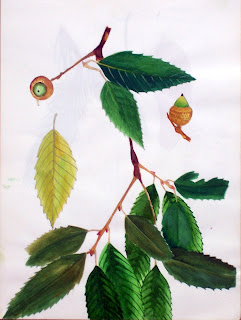Planting a Tree
We all some time or another have got an opportunity to plant a tree, but many of us do not know how a tree should be planted in the right way. Well it is not as difficult as we think. When I started planting trees I thought that it is absolutely essential to dig a big pit, remove the soil which already existed there refill the pit with red soil( literate soil ) mixed with cow dung manure and then plant the tree of your choice. Well this is what I used to do. Nothing but a huge waste of human energy, we really need not go through all this trouble if we want to grow a tree successfully. Many times we end up learning the wrong technique from books and so called experts. In reality we need not do all this if we had just observed how plants grow up in natural conditions. Under natural conditions a seed falls on the ground and when the conditions are right it starts growing, there is no digging of huge pits or holes on the ground and mixing soil with cow dung manure.
Well let me tell you how I plant trees now. It is not at all difficult, if you are planting a tree in an area where there is already a good amount of soil. (Like more than 1 ½ feet) There is no need of digging at all, just remove enough soil as to properly plant a sapling or seed on ground. In the case of a seed, just push one in the ground as deep as the size of a seed.
After purchasing a sapling from nursery, clean a patch of land by removing the surface vegetation and organic matter.

After this slit open the nursery bag as shown in the photo

Place it in the dug hole, and if the sapling fit in the dug hole that is more than enough. Make sure that the stem is not covered with more than 1 inch of soil. If this happens it can cause decay or rottening of the stem.

After doing this fill the gap around the sapling with soil.

With the help of a “HOE” clean the surrounding area (this is not for clearing the weeds but to demarcate the area.) for comfortable holding and digging, hold the “HOE” in a slanting position and while digging swing the “HOE” making sure that your arms move freely to wards the back.
After this make a small mud wall around the planted sapling so that the pored water does not spill out.

Cover the exposed part with dry leaf or mulched leaves. This is to prevent desiccation and drying up of the soil. It also promotes soil bacteria, detritus feeders and other organisms to dwell in it. The hygroscopic moisture content increases in the soil as soon as leaf mulch is added. Thus helping the plant to grow.
 Finally water the sapling.
Finally water the sapling.
Advantages of mulching

Mulching is a process of maintaining a layer of partially decomposed leaf and vegetable matter on the surface of the soil. This is particularly helpful for plants because it reduces lose of moisture from the soil by reducing the amount of sunlight which directly falls on the ground. To understand this take a soil thermometer and check the soil temperature in a open field which is devoid of vegetation and bio-mass, then check a land with leaf mulch and finally check a patch under a tree or small shrub which contains a good soil bio-mass or mulch. You will find that there is a definite difference between the three scenarios. Not only will you find a definite temperature difference but also heat and moisture.
In the first scenario you will find that the soil is dry, hard, devoid of vegetation and will have a high soil temperature. And if you take the extra effort to dig the soil you will find that it is moist only after one feet, this is because intensity of the heat is not able to penetrate up to this depth (this is in the case of PUNE).
In the second scenario you will find that the soil moisture is high but because of the lack of vegetation the surface temperature to be high.
And in the final and third scenario because of the vegetation cover and soil bio-mass, temperature is low and the soil moisture high, decomposition and release of nutrients to be good and the soil color dark red, brown or black according to the different soil types.
This is why mulching is so important.











